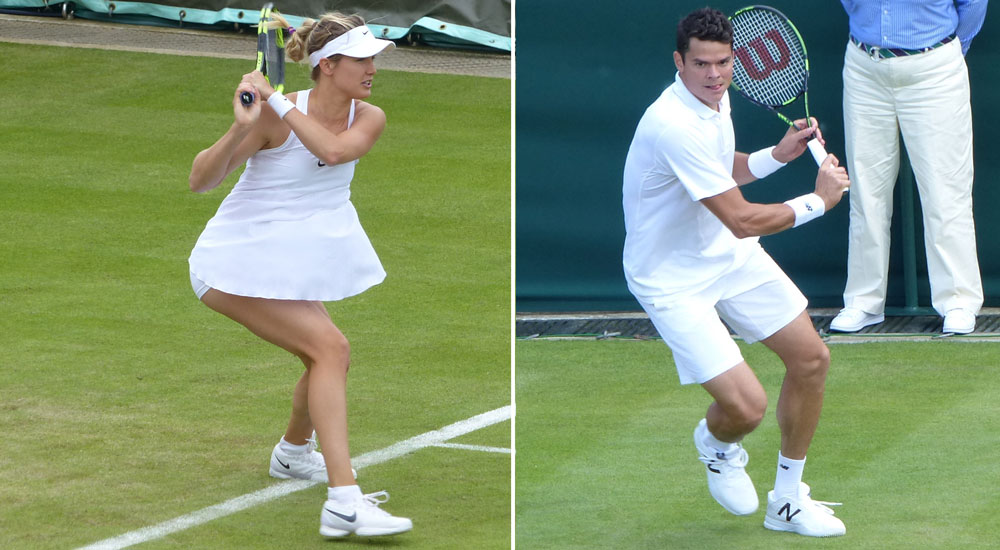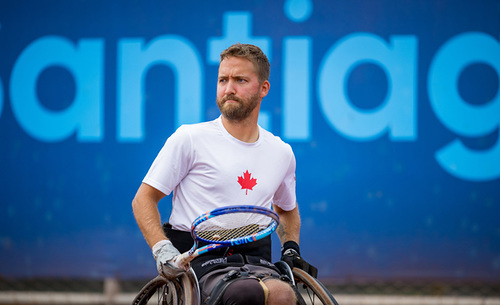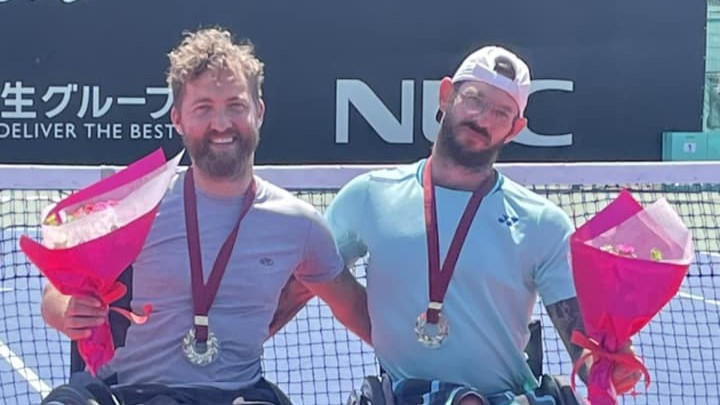
After four days of the 2016 Wimbledon championships, Genie Bouchard and Milos Raonic have already combined to win twice as many matches (four) as one year ago. Then, Bouchard lost in the first round and Raonic went out in round three, which was a dramatic drop-off from a year earlier when they won an impressive 11 matches together – Bouchard reaching the 2014 final and Raonic making it to the semifinals.
On Thursday both showed the quality of tennis they would like to consistently play – Bouchard overcoming a game Jo Konta 6-3, 1-6, 6-1 and Raonic outclassing Andreas Seppi 7-6(5), 6-4, 6-2.
The Bouchard victory in Centre Court, with the crowd partisan but not outrageously so, was the more remarkable because later she described it as “my best performance of 2016.” As for Raonic, he went as far as to say “I played well” but wasn’t about to put the one-hour and 57-minute outing on No. 3 Court as a highlight of his current season.
In a sense, the No. 48-ranked Bouchard vs. the No. 19-ranked Konta could have been billed as pedigree vs. form. Bouchard has been in one Grand Slam final and two semifinals and has an overall record in the majors of 34-12. Konta has been to one fourth round (US Open ’15) and the semifinals of this year’s Australian Open and is 10-11 at the majors. She is, at 25, also three years older than the 22-year-old Bouchard.
But thus far in 2016, Konta had been the superior performer, moving her ranking from No. 47 to No. 19 when Bouchard has basically stagnated – starting 2016 at No. 48, which is where she stands at the moment.
Konta, of Hungarian descent, basically confirmed the pedigree of Bouchard when she said about her in the media conference, “her level of tennis has never disappeared. It doesn’t disappear just like that (snapping her fingers). She’s an incredibly good tennis player and competitor.”
The match started much in Konta’s favour as she broke serve in the third game and as the players walked off at the 2-1 changeover Bouchard looked a little shaken by the pace of her opponent’s shots. But leading 15-love in the next game, Konta set up a point perfectly but then badly bungled a backhand volley into the net. That seemed to rattle her and Bouchard gradually took over to win the set with some rock solid tennis.
In the second set, it was a role reversal, Bouchard started misfiring and Konta steadied to run off to a 3-0 lead and eventually withstand a couple of sketchy moments to close it out 6-1.
The players took a bathroom break at the end of the set and when they resumed Bouchard saved three break points to hold serve to 1-0. She then broke serve in a shaky game from Konta that included two double faults. In the third game, Bouchard survived a love-40 deficit – three break points – to hold serve and pretty well wrap up the match on her way to leading 5-0. The match ended on a forehand long that Konta challenged. So, as in Bouchard’s previous match against Magdalena Rybarikova, she got a favourable Hawk-Eye ruling on the match point that concluded the contest.

Bouchard wasn’t overly expressive after winning, later explaining, “I’m so focused during the match that I almost don’t realize the match is over. It’s almost as if I didn’t want the match to end – I was enjoying myself out there.”
It was obvious to see the poise and consistency of Bouchard’s game, and 18-time Grand Slam champion Chris Evert may have best described it when she said, “in the last year, it’s one of the few times I’ve seen her play free of tension, free of pressure.”
Bouchard said she was pleased with her level throughout the match and explained about turning things around in the third set, “in the second set I didn’t play necessarily bad, but I think she raised her level. She cut back on a few errors and was even more aggressive. So I tried to be the one to do that in the third set. Any short ball, any slower‑paced ball, I gave her she would attack and give me no chance, which is what you have to expect against a Top 20 player. I focused on the third set to try and not give her any of those balls.”
Some of the improvement in her tennis must be attributable to reuniting with long-time coach Nick Saviano in April. “(It’s) definitely a part of it, of course,” Bouchard said about the 60-year-old who has an eponymous tennis academy in Plantation, Florida. “I have been working really hard, even when I haven’t been doing well.
“I feel now that I may be more on the right path and working hard in the right areas. That can definitely make a difference.”
About where her headspace is at now compared to darker times over the past year, Bouchard said, “I feel more focused on the court and having specific objectives in my mind and not worrying about anything outside the court. Because when I’m on the court, that’s my job and that’s the only thing I have to worry about.”

Her next job will be to try to reach Monday’s round-of-16 with a win over No. 19 seed Dominka Cibulkova in the third round. On Thursday, the No. 18-ranked Slovak defeated Daria Gavrilova of Australia 6-3, 6-2. Bouchard has won both previous matches with Cibulkova – earlier this year in Hobart, Australia, by a 6-1, 4-6, 6-1 score in the semifinals and famously 7-6(9), 4-6, 6-3 in a two-hour and 40-minute, third-round clash at the 2015 US Open just a few hours before she fell and suffered a concussion in the locker room.
About facing the diminutive – 5-foot-3 – but extremely combative Cibulkova, Bouchard said, “she’s a fighter and just won the tournament in Eastbourne last week. Every match I had against her was really a tough battle, physical and mental.”
Bouchard, who has now played three days in a row with the two-day completion of her opening-round match against Rybarikova, added, “I have a rest day tomorrow and then I’m going to give it my all on Saturday.”

Milos Raonic’s victory over Andreas Seppi on No. 3 Court (above) on Thursday had similarities to his opening round 7-6(4), 6-2, 6-4 win over Pablo Carreno Busta of Spain. The veteran Seppi (32) was able to stay with Raonic for one tiebreak set but then the world No. 7 gradually gained the upper hand and won going away.
Raonic had to survive two break points in his very first service game, also the first of the match, and narrowly outpointed Seppi 35-34 as they were about to enter the first-set tiebreak. Right off he got a mini-break to lead 2-0 which lasted until Seppi got it back and was serving trailing 4-5. But Raonic regained the advantage immediately thanks to a low bouncing backhand approach shot that Seppi couldn’t handle and missed into the net with his passing shot. A forehand into the top of the net by Seppi on the 12th point of the tiebreak and Raonic had the opening set in 54 minutes.
A early break in the second and it gradually became clear that the man who would end up with 25 aces (two for Seppi) and a winners-to-unforced-errors ratio of 41/19 was going to be the one advancing to the third round.
All in all it was a cleaner performance than Raonic’s first round, with his net approaches success rate of 19/26 being eloquent proof of that.
Still Seppi presented a real challenge in the first set, which was delayed for a few minutes right before the tiebreak when rain began to sprinkle.
Raonic would later explain about a conversation he had with Moroccan umpire Mohamed El Jennati, “you’re in a tiebreak and you don’t want to play it with any sort of hesitation. That court, in 2011, is the court I slipped on, actually on the other side from where I was at the start of the tiebreak.
“I slipped on that court after a long rain delay after the court was a little bit humid. (About two weeks later) I was in surgery. It just wasn’t something I wanted to play with on my mind.
“Thankfully the umpire was understanding. I wasn’t decisive in saying, ‘no I’m not going to play,’ but I openly discussed it with him.
“We resumed with maybe not ideal conditions, because it was still a little bit moist, but at least less thought of it on my mind.”

Raonic is now 2-0 with Seppi but had praise for the Italian, a competitor he has practiced with quite a bit. “I thought he played quite well,” Raonic said, “he never let me get a rhythm, even though I was trying not to let him get a rhythm. He was hitting the ball pretty hard. The ball was staying pretty low. It was hard to really get some looks to be too aggressive with. I had to always be looking to change the shots up and bring him out of his repertoire.”
The oft-mentioned Raonic forward moves to the net tactic paid dividends, as was noted above in his net approaches stats. “I thought he was doing a good job of hitting hard and deep,” Raonic noted about his net approaches on another cool, overcast day at the All England Club. “I would have liked to have created more chances to come forward. When I did, it did pay off. I was pretty efficient there, which is nice.”
Next up for Raonic on No. 1 Court on Friday (roughly between noon and 2 p.m. EDT in Canada) will be Jack Sock. He leads their head-to-head 7-1, including having won the past seven in a row and 15 of the previous 17 sets they have contested. That includes a 6-3, 6-4, 6-4 victory over the No. 26-ranked American at Wimbledon in 2014.
“I have to serve well,” Raonic said about the match-up with the 23-year-old from Tampa, Florida. “We’ve played a lot of times. I’ve been able to find the solutions most of the time. I’ve got to take care of the serve. I’ve always found a way to be the one dictating, controlling. It’s always eventually paid off throughout the difficult matches for me.”
Raonic’s decision to bring in John McEnroe as a consulting coach was always going to be highly-scrutinized, so it’s probably no surprise that a rumour surfaced on Thursday that he and the larger-than-life American had split up – possibly because the 57-year-old American wasn’t present for Thursday’s match.
“I was just told about it,” Raonic said about the McEnroe story. “It’s inaccurate. He was there with me this morning. Obviously he’s trying to be there as much as he can. It depends what kind of commentating schedule he gets that day.
“For the first round, it worked out. Today it didn’t because I believe he was calling the first two matches on Centre Court.”
Shamasdin in doubles upset

Adil Shamasdin of Pickering, Ont. and his British partner Jonathan Marray caused a major surprise on the opening day of doubles competition Thursday, defeating the reigning Wimbledon champions, Jean-Julien Rojer of Netherlands and Horia Tecau of Romania, 6-2, 7-6(3) in the opening round.
The British – Canadian pair were given a wild card into the event largely on the basis of Marray having won the Wimbledon doubles in 2012 with Danish partner Frederik Nielsen.
Shamasdin was a steady performer during the match but the best player on the court was Marray who did a masterful job volleying at the net.
 “I’m pretty happy, everything went according to plan,” Shamasdin (above being escorted after the match) said shortly after winning. “We worked on a lot of stuff throughout this last month so it’s nice to finally get something on the board. We executed well and took advantage of all the opportunities we got.”
“I’m pretty happy, everything went according to plan,” Shamasdin (above being escorted after the match) said shortly after winning. “We worked on a lot of stuff throughout this last month so it’s nice to finally get something on the board. We executed well and took advantage of all the opportunities we got.”
Asked what he was most pleased with in his game, Shamasdin, 34 and ranked No. 117 in doubles, said, “I’d say my serve. I had a high first-serve percentage and my returns – I was able to get a lot of balls in. It wasn’t so much hit-and-miss winners. I just tried to make balls and that kind of helped Jonny come into play. He’s very good at the net. He cleans up after me.”
The men’s doubles first round has been reduced to two-out-of-three sets because of the backlog of matches caused by inclement weather. “I don’t know,” Shamasdin answered when asked about what factor the format change might have been. He added, “Jonny’s won here before so I’ll just jump on his back and see how that goes. Obviously we were able to get it done pretty early. We’re happy with that and looking forward to the next round.”

Right after the match, Marray walked off with Louis Cayer, the former Canadian Davis Cup captain who is currently a doubles specialist coach with the (British) Lawn Tennis Association. Cayer could be heard saying to Marray, “you served great and you stayed calm.”
In the second round, Shamasdin and Marray, 35 and ranked No. 89, will face the winner of a match between Britons Kyle Edmund and James Ward and Argentines Federico Delbonis and Diego Schwartzman.
Wimbledon post card

There’s a huge parkland area about a mile west of the All England Club known as Wimbledon Common. As is obvious in the picture here, Wimbledon Common is barren and large – and the picture above just shows a small portion of it.


